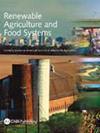Effect of zinc and protein content in different barley cultivars: use of controlled release matrices
IF 2
3区 农林科学
Q2 AGRICULTURE, MULTIDISCIPLINARY
引用次数: 0
Abstract
Abstract Barley is one of the most consumed cereals, with many different cultivars available worldwide. Like other crops, its yield has been affected by climate change and soil degradation. This work proposes controlled-release protein-based matrices with incorporated zinc to improve barley seed germination and zinc content in the plant. Thus, the main objective of this study was to investigate the use of controlled-release protein-based matrices for massive crops, such as barley. Different barley cultivars of barley were studied: Barke, Golden Promise, Morex, WB-200, WB379, and WB-446. The seeds of each cultivar were also analyzed in order to explain the behavior of plants observed during the growth. To this end, the physico-chemical (FT-IR, Raman spectroscopy, and Zn concentration) and microstructural (SEM) properties of the different seeds were firstly evaluated to establish differences between the studied cultivars. In addition, the use of controlled-release soybean protein-based matrices without zinc (M) or with zinc incorporated (MZ) was evaluated as fertilizers in the different barley cultivars. In this sense, the use of these matrices as a zinc carrier improved seed germination and zinc content in the plants, indicating that the use of matrices improves the amount of zinc assimilated by the crops (up to 30 and 50% with M and MZ, respectively) and allows the proper root growth of all cultivars of barley. In conclusion, this article shows the potential of controlled-release protein-based matrices as substitutes for conventional fertilization.不同大麦品种锌和蛋白质含量的影响:控释基质的应用
大麦是消费最多的谷物之一,在世界范围内有许多不同的品种。与其他作物一样,它的产量也受到气候变化和土壤退化的影响。本研究提出了一种含有锌的控释蛋白基质,以提高大麦种子萌发率和植物中锌的含量。因此,本研究的主要目的是研究基于控释蛋白的基质在大型作物(如大麦)中的应用。以大麦品种Barke、Golden Promise、Morex、WB-200、WB379和WB-446为研究对象。为了解释在生长过程中观察到的植物行为,还对每个品种的种子进行了分析。为此,首先对不同品种种子的理化性质(FT-IR、拉曼光谱和Zn浓度)和微观结构(SEM)特性进行了评价,以确定不同品种之间的差异。此外,还对不加锌(M)和加锌(MZ)的大豆蛋白基缓释基质在不同大麦品种上的施用效果进行了评价。从这个意义上说,使用这些基质作为锌载体提高了种子萌发和植物中的锌含量,这表明基质的使用提高了作物吸收锌的量(M和MZ分别高达30%和50%),并允许所有大麦品种的根正常生长。总之,本文显示了控释蛋白基质作为常规施肥替代品的潜力。
本文章由计算机程序翻译,如有差异,请以英文原文为准。
求助全文
约1分钟内获得全文
求助全文
来源期刊

Renewable Agriculture and Food Systems
农林科学-农业综合
CiteScore
5.20
自引率
7.40%
发文量
39
审稿时长
>36 weeks
期刊介绍:
Renewable Agriculture and Food Systems (formerly American Journal of Alternative Agriculture) is a multi-disciplinary journal which focuses on the science that underpins economically, environmentally, and socially sustainable approaches to agriculture and food production. The journal publishes original research and review articles on the economic, ecological, and environmental impacts of agriculture; the effective use of renewable resources and biodiversity in agro-ecosystems; and the technological and sociological implications of sustainable food systems. It also contains a discussion forum, which presents lively discussions on new and provocative topics.
 求助内容:
求助内容: 应助结果提醒方式:
应助结果提醒方式:


